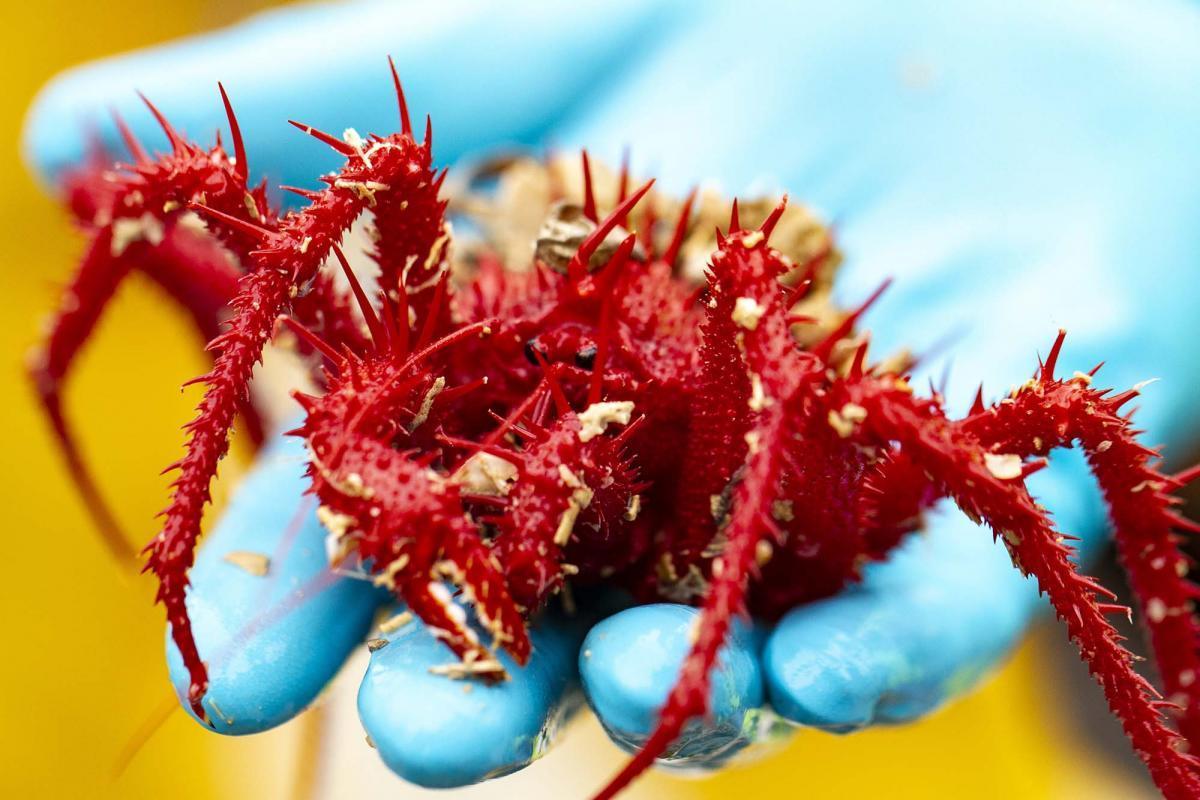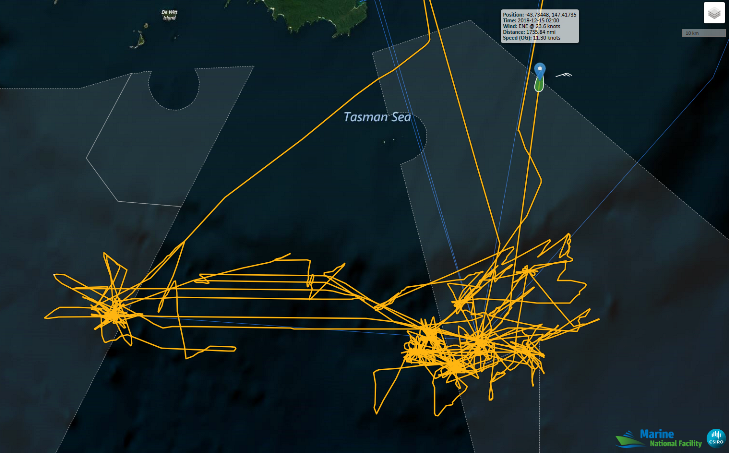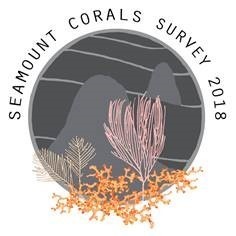December 19, 2018

New areas of deep-sea coral reef and more than 100 unnamed species – including corals, lobsters and molluscs– have been discovered on undersea mountains in marine parks south of Tasmania.
Scientists and park managers returned to Hobart today after a four-week survey of the seamounts on CSIRO research vessel Investigator led by CSIRO.
The unusual cluster of more than 100 seamounts is world-renowned for its deep-sea corals and diverse marine life. Most of the seamounts are protected in Australia’s Tasman Fracture and Huon marine parks, which are managed by Parks Australia.
For the first time, new technologies enabled scientists to look at rocky habitats between the seamounts that support deep-sea corals, in particular the main reef-building stony coral, Solenosmilia variabilis.
“We surveyed 45 seamounts in total, and criss-crossed seven in detail completing a total of 147 transects covering 200 kilometres in length,” voyage chief scientist Alan Williams of CSIRO said.
“We ‘flew’ our high-tech camera system two metres above the seafloor in depths to 1900 metres, collecting 60,000 stereo images and some 300 hours of video for analysis.

“While it will take months to fully analyse the coral distributions, we have already seen healthy deep-sea coral communities on many smaller seafloor hills and raised ridges away from the seamounts, to depths of 1450 m.
“This means that there is more of this important coral reef in the Huon and Tasman Fracture marine parks than we previously realised.”
Live imagery from the deep-tow camera systems revealed dense coral reefs, as well as hundreds of animals including feathery, solitary soft corals, tulip-shaped glass sponges and crinoids attached to the seafloor. Their colours ranged from delicate creams and pinks to striking purples, bright yellows and golds.
Bioluminescent squids, ghost sharks, deep-water sharks, rays, orange roughy, oreos and basketwork eels were also seen near the seafloor. And from above the water, an observation team collected data on more than 40 species of seabirds, and several whale and dolphin species.
A small net was used to collect biological samples for identification, and many new species were found, as is expected in such remote environments. A high proportion of the mollusc species collected were unknown.
There were many instances of mutually beneficial relationships among the samples, with brittlestars curled around corals, polychaete worms tunnelling inside corals, and corals growing on the surface of shells.
“We now have a huge body of data on the animals that live on seamounts and how their communities change with depth, and have a much broader picture of what lives on habitats adjacent to the seamounts,” Dr Williams said.
“We have identified the precise depth range in which the diverse Solenosmilia community thrives. On the larger seamounts which peak in 1000–1250 m depth below the sea surface, corals dominate the top 100–200 m.
“Our detailed sampling was on seamounts that were previously impacted by bottom fishing but have been protected since for more than 20 years.
“While we saw no evidence that the coral communities are recovering, there were signs that some individual species of corals, featherstars and urchins have re-established a foothold.”
Head of Parks Australia’s Marine Protected Areas Branch, Jason Mundy, was part of the Parks Australia team that joined the seamounts survey.
“Research voyages such as these are critically important to helping us understand, appreciate and protect Australian Marine Parks,” he said.
“The images from this voyage remind us what extraordinary and diverse environments we are protecting in these special places.”
New information collected on the Investigator survey will give scientists a clear, quantitative picture of where and at what depth different species and communities live in these marine parks, and a foundation for predicting their likely occurrence both in Australia and around the world.
The seamount corals survey involved 10 organisations: CSIRO, the National Environmental Science Program Marine Biodiversity Hub, Australian Museum, Museums Victoria, Tasmanian Museum and Art Gallery, NIWA (NZ), three Australian universities and Parks Australia.
Background
Off southern Tasmania, in depths between 700 and 1500 metres, more than 100 undersea mountains provide rocky pedestals for deep-sea coral reefs. Their extent and biodiversity of these reefs identifies this unusual seamount cluster as globally significant ecological area.
Unlike shallow tropical corals, deep-sea corals live in a cold environment without sunlight or symbiotic algae. They feed on tiny organisms filtered from passing currents, and protect an assortment other animals in their intricate structures.
Deep-sea corals are fragile and slow-growing, and vulnerable to human activities such as fishing, mining and climate-related changes in ocean temperatures and acidity.
To help manage these risks, there is an urgent need to map the locations of deep-sea corals in the world’s oceans, and learn more about the resilience of coral-associated communities.
Australia’s contribution to this field of research is to survey deep-sea corals with a towed camera system that provides quantitative data on coral abundance, size and health. The work is carried out aboard the CSIRO research vessel Investigator (part of Australia’s Marine National Facility).
This week we returned a research voyage that criss-crossed many seamounts in and near the Huon and Tasman Fracture marine parks which are home to both pristine and previously fished coral reefs. These two parks are part of a larger network of Australian Marine Parks that surround Australia’s coastline and protect our offshore marine environment.
The data we collected will answer our two key research questions: what grows where in these environments, and are corals regrowing after more than 20 years of protection?
Media
Bryony Bennett, NESP Marine Biodiversity Hub, 0438 175 268, bryony@lightbox42.com.au
Join us next to RV Investigator to speak with returning scientists and park managers about their discoveries. A media package of images and video will also be provided at the event.
When
11:00am on Wednesday, 19 December 2018
Where
CSIRO Marine Laboratories, Castray Esplanade, Battery Point
Meet at the viewing platform behind the building (next to the ship)
Who
Dr Alan Williams, Voyage Chief Scientist, CSIRO
Prof Nic Bax, Director, NESP Marine Biodiversity Hub
Jason Mundy, Assistant Secretary (Marine Protected Areas), Parks Australia
Resources
- View the Seamount Corals Survey blog - 23 November to 19 December 2018 https://www.nespmarine.edu.au/seamounts/landing-page
- Download media release New deep-sea delights discovered in marine parks south of Tasmania - 19 December 2018
- Imagery for the Seamount Corals Survey 2018 can be downloaded via this link https://www.dropbox.com/sh/elbuj8t6l7t7p2s/AAB-mIXCSNHOvxdxZ3DvcrVia?dl=0
- Article in The Conversation - Exploring Australia’s ‘other reefs’ south of Tasmania - 19 December 2018
- Log in to post comments

